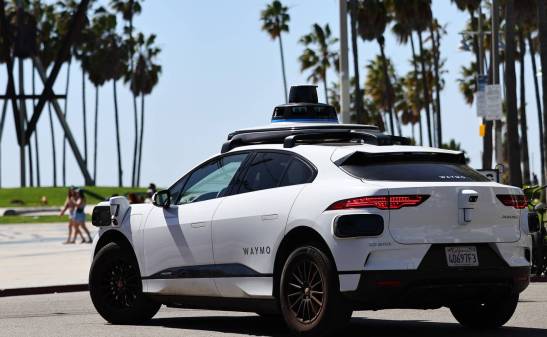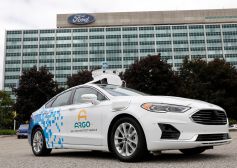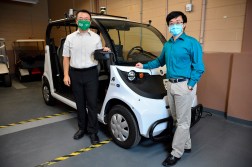How states are preparing for connected vehicles in 2018

As the auto industry urges Congress to rush self-driving vehicles onto America’s roadways, a quieter discussion is happening inside state government transportation authorities around the country.
Reports pop up on Twitter daily of autonomous delivery robots patrolling sidewalks in Washington, D.C., or Sunnyvale, California. Self-driving vehicles are already being tested on public roads in states like California, Washington, Texas, Michigan, Pennsylvania and Massachusetts. Even the most conservative estimates place the arrival date of fully autonomous technology sometime within the next 20 years, while more optimistic technologists — like Tesla’s Elon Musk — predict the technology will be ready this year.
Though hurdles remain before there is widespread public adoption, the aggressive testing of autonomous technology has some states doing everything they can to prepare for a driverless future. And the earliest versions of the next generation of transportation technology, officials tell StateScoop, will begin testing by next year. While political, legal and technological preparations by government to enable widespread adoption of self-driving vehicles — also known as autonomous vehicles — may take several years at least, some of the technology’s stepping stones are already surfacing.
Connected vehicles — those that include sensors and radios that allow communication with other vehicles and roadway infrastructure — must overcome a lower threshold to meet safety standards and societal acceptance. And while the arrival of self-driving vehicles is largely a matter of when Congress will allow the technology to be sold and used publicly, connected vehicle adoption is predicated on the existence of physical infrastructure and a critical mass of users that would make inter-car communication useful.
Debate on exactly when self-driving vehicles will arrive continues, but connected vehicles are here now.
Jumping directly into autonomous technology is a little scary, said Greg Bedalov, executive director of the Illinois Tollway, which is why the agency is bridging into the technology with connected vehicles first. The tollway installed a “smart road” that Bedalov told StateScoop is expected to go live by October.
Located on the Jane Addams Memorial Tollway, also known as I-90, the new road will be equipped with a $33 million active traffic management system. Twenty-nine gantries will be installed every half mile between O’Hare International Airport and Barrington Road, allowing the state to monitor and adjust in real time the status of traffic incidents, speed advisories, proposed alternate routes, lane closures, and traffic pattern changes. They call it their “smart corridor.”
The system will also include an upgraded camera system, wireless traffic sensors, new weather stations and the so-called “flexible infrastructure” that will allow “vehicles of the future” to communicate with one another on the road, Bedalov said.
The state’s maintenance vehicle fleet has already been equipped with sensors that allow for the new interconnectivity and monitoring, Bedalov said, supported by freshly installed fiber lines running along the tollway. An autonomous vehicle pilot is also in the works, he said, though no firm timeline has yet been announced.
Preparation for autonomous and connected vehicles is equally fierce in Ohio, where collaboration between regional transit authorities, nearby states and research institutions like the Transportation Research Center has already prompted projects like Ohio’s Smart Mobility Corridor and a smart city program underway in Columbus after the award of a $40 million grant from the U.S. Department of Transportation.
Doing something
Randy Cole, executive director of the Ohio Turnpike and Infrastructure Commission told StateScoop that the state’s many projects around next-generation transportation are designed around the concept of collaboration, so that when the technology does arrive, the region is coordinated for adoption.
“We’re putting as many of the pieces of the puzzle together and they’re not just duplicating effort or independent efforts that don’t add up to something bigger,” Cole said. “I think that’s exciting thing about the approach we’re taking here.”
Like Illinois, Ohio is ready for connected vehicles first. The state is in the final stages of “spec’ing out the implementation of a dedicated short-range communication” system that runs a 60 mile stretch of the 241-mile turnpike, Cole said. Thirty-eight maintenance vehicles have been equipped with tracking devices and sensors to help the state prove the technology works — hopefully the project will be operational early next year, he said.
The idea behind the new technology is to enable the to state respond more quickly to incidents and keep traffic moving. For years states have been using intelligent transportation systems (ITS) that use video cameras and sensors to monitor traffic and roadway conditions. The new generation of personal and freight transportation vehicles will require operational changes that could take states time to adjust.
“What we’re trying to do is ‘operationalize’ those technologies,” Cole said. “When I say that, it means not just installing some units out on the road — radios on the road and receivers in the vehicles, but it’s buying the software. It’s making sure our radio room, our comm center for incident response is migrating their operations — it’s people and processes and technology. The part we’re really trying to work on is the people and the processes part.”
The tollway is working with the states of Michigan and Pennsylvania, local academic institutions and research centers, and state departments including Transportation, Public Safety, and Jobs Ohio to “share data and align efforts,” Cole said.
“We need to make sure those emerging technologies are part of that advancement in that industry sector here,” Cole said. “It’s only natural. We were here where tires and cars were first produced and we now take those next stages in their evolution.”
Doing nothing
While states like Ohio, Illinois and a handful of others become prolific in their preparation for autonomous transportation, others think it wiser to take a reactive approach.
Gary Trietsch, director of the Harris County Toll Road Authority in Houston, Texas, said his 50 years of experience working in transportation tells him that the best preparation for autonomous vehicles is “nothing.”
“I’ve seen people get all excited about this stuff and get out there and spend a lot of time and effort and then it never comes to fruition,” Trietsch said. “You know, I’ll be the first to ride in a driverless car. I can’t wait until I can call Uber and a vehicle shows up without a driver, but that may be decades off or ten years off. I just don’t know. We’re keeping an eye on it. I’ll say that much. But I haven’t seen anything that makes me want to change or do anything than we’re already doing.”
Trietsch, who worked for the Texas Department of Transportation for more than 40 years before managing the county toll road, said that he remembers a similar reaction in transportation when intelligent highway vehicle systems (IHVS) arrived in the 1980s and then morphed into ITS. Eventually, he said, the technology adapts to the roads.
“I don’t even have an individual devoted to this,” he said. “As soon as they’re ready to say ‘we need this,’ we’ll do that, but until somebody tells me, I’m not going to spend any time, effort or money on guesses.”
Officials like Trietsch appear to be outnumbered by those like Cole, who said that being proactive both with regard to policy and technology could improve the roadways and potentially save lives.
“We’re analyzing data,” Cole said, “and watching what’s happening so that we can either predict something or more quickly respond instead of just reactively waiting for that emergency call.”






